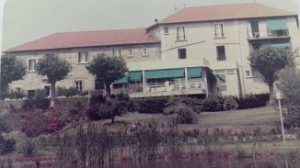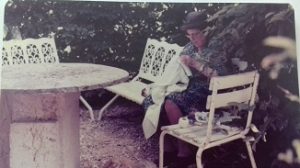The idea of the Blog developed while talking to Joan Duncan and reading her detailed account of living in London during the war years. The first story of the Blog called When the War Began, was by her. Joan was a prolific writer and an ardent traveler. All by herself, she made several trips a year by ship or train as she disliked flying. She was in Spain this September when she suffered a heart attack and sadly passed away on the 23rd of September 2017, at the age of 93.
Joan loved travelling to France and the following story is about one of her first visits. She was happy for me to publish it in two parts. Her daughter-in-law Nicola Duncan, has kindly consented to my publishing them now. This is my way of saying Thank you Joan, I am going to miss you sorely.
These stories of travels through the French countryside were written as soon as I returned home, while the memories were very fresh in my mind.
First Visit to Lyon —–1979
Following a very tragic and sad period of our lives, son Peter, husband Neil and I found ourselves, during the summer of 1979, in need of rest and a change of scenery for a while. We decided to take a holiday in a place which would be completely new to us; we chose Lyon, which we thought would make a good centre for exploring a part of France none of us had visited before.
After a day or so in Paris, which we all knew well, we boarded the train at the Gare de Lyon for the four- hour journey south. We passed through some interesting countryside and I was able to see Dijon in daylight for the first time—previously I had always roared through that part of France by night. Several famous Burgundy vineyards were passed as we journeyed down the Saône valley, and then, at last we drew into Perrache Station in Lyon, and caught our first glimpse of the Rhône. The station, to which visitors come from all over France, stands on the slip of land between the two great rivers which converge a short distance away.
Outside Perrache Station we crossed the many small roads and found the bus station by way of a large covered shopping area which is on several levels, and has the usual French collection of moving stairways through glass tubes. We finally emerged into a large square, full of flower beds, fountains and statues; this led into the main shopping area whose road runs for about two miles. All this area is for the pedestrians only, which makes window shopping a great joy, at any time of day. The streets were filled with flags and bunting and flowers, and we arrived in time for weekend street markets. All was noise and bustle, and there seemed to be visitors from everywhere in the world. We stayed for a day or so, which gave us time to have a look at the old city of Lyon, on the opposite bank of Saône. There is a very old Cathedral on the top of an almost sheer cliff above the river; the easiest way to the top is by the funicular railway—a quite exciting ride! We also spent an afternoon in Parc de la Tete-d’Or which is in the opposite direction across the Rhône. Neil and Peter took a boat out on the lake while I visited the Rose Garden, which, after the one in Regent’s Park, is the best I have seen anywhere. We also discovered a small zoo within the same park.
It is often said that the best French cooking is to be found in Lyon, and if I judge by the meals we had there, I must confirm this: every dish would delight any gourmet. Even the little snack in the square by the station offered the most mouth-watering snacks, and omelettes of all kinds. The lady there was a most remarkable cook, who could produce a feast within a few minutes, all freshly prepared, and cooked to order. We were astonished how cheaply we could eat such high quality food. I loved Lyon, and still feel completely at home there; I don’t know why, especially as Neil and Peter think it a rather dirty, scruffy place, which it is really, I suppose.
 |
| The Hotel in Vaugneray |
Not having much idea where to go next, we visited the Tourist Office (Le Syndicat d’ Initiative) in the station complex, and asked about the neighbouring areas; we had the idea that if we could find a nice quiet place out of town, perhaps at the end of a bus route, we could come back into town to hire a car when we felt ready. After some conversation, we decided on Vaugneray, a little village to the west of Lyon; the young woman in the office rang the only suitable “hotel,” and booked us in, much to the owner’s surprise, as English visitors were something of a rarity. We hadn’t realised how few British actually stay in Vaugneray, though the odd one or two have been known to drive through, on their way across France. We were welcomed with great warmth by the family who owned the hotel, and by the guests. I cannot put into words the feeling of peace and rest that the nine days spent there brought us.
 |
| The garden at the back |
The house was at the bottom of the hill which leads up to Vaugneray, and the green, rolling Lyonnaise mountains spread themselves before us. We had a lovely view from our bedroom balcony of both the countryside and the splendid garden,with its small lake. The hotel and restaurant were owned and run by the family: – Mme. Besson and her daughter and son-in-law, M. and Mme. Midey, and their two daughters (one married); there were also the daughter’s husband and two little boys. The whole place was scrupulously clean and the accommodation was surprisingly modern-we had a very nice private bathroom, for instance. The hotel was filled with elderly people, mainly little old ladies, who were obviously regular summer visitors. We were the subject of much curiosity, but it didn’t take long for the ice to melt, and soon we were all the best of friends. It was Wimbledon ‘finals week,’ and we were surprised how interested everyone was in the tennis; every evening, when we came through the lounge, the chairs were lined up in front of the T.V., and the air was full of comments on the play. Peter was quite a favourite with the old ladies, though he must have felt rather out of place there; one lady had her 12-year-old grandson with her, and she asked if Peter would play tennis with him; the assembled ladies were very pleased when Peter agreed, and further excitement was caused when they learned that he was studying at the same University as Sebastian Coe, who had just broken the 800 m. world record (this was also viewed in the lounge).
 |
| The lady with the dog |
One rather eccentric old lady was the owner of a yappy little Yorkshire terrier, who followed her everywhere, and had frequent arguments with the hotel kitten; this lady kept us highly entertained, and if we came across her in her favourite seat in the little arbour in the garden, she would give us a long lecture on the state of French politics since the war; she usually ended her speeches with “Vive La France, Vive L’Angleterre!”; everyone was pro-British-their generation had seen much suffering in the Lyon area during the war. There was one old gentleman amongst the old ladies; he said very little to anyone, and scarcely seemed to notice us; every morning he walked up the hill to fetch his newspaper, which remained with him for the rest of the day; he caused Peter a lot of amusement by walking into broom cupboards instead of his room.
Everyone in the hotel got up for breakfast at about 6 am and was in bed by 9.30 pm.; we were locked out one night because we went down to the lake to look at the frogs, who used to keep up a loud chorus all night. It took some time at 10 pm. to make anyone hear us, and we were finally let in by the giggling waitress/chambermaid who thought it all extremely funny. Needless to say, we did not get up at 6 am. but had a very leisurely start to most days at about 9.30 am., but no one minded in the least. The high-spot of our nine days there was the birthday party for “La Grandmere” – the family were up even earlier than usual, busily preparing the feast! We were all included in the celebration-the restaurant was closed for the day, a long table was set up for the family down the middle of the room, and the guests’ tables were placed all round it. The first course was snails stuffed with garlic and herbs (thankfully not in their shells), then various other courses emerged before the climax of the feast, when everyone was served with a quail. The local custom was to serve everything separately, and it was sometimes difficult to know how to deal with a large plate of green beans, for instance, not knowing what or how much was to follow. Everything was cooked to perfection, with the most delicate flavourings added, and I am sure that those quails, sitting in the middle of our plates, surrounded by a delicious sauce, were a culinary triumph, but —–the sight of a complete whole bird with neck and head still on, its little eyes staring pathetically at me, turned my stomach over, and I did not know what to do! I think Neil and Peter too were affected, and we picked at our birds, trying not to look too hard at the plates. Some of the ladies saw that something was not quite right, and enquired whether we disliked quail; we made our excuses best we could and hoped the family hadn’t noticed. We washed everything down with the excellent Rhône wine, which had the restaurant’s own label on the bottle. I don’t remember what we had to follow the quail, but on most days, there was an excellent supply of fruit, often fresh-picked from the garden, home-made tarts, a large platter of cheeses, and excellent coffee. Meals were always a source of interest, surprises, and enjoyment, and we lived like lords and ladies of old; the oddest part to us was the ‘compulsory’ retention of one’s knife and fork! It didn’t matter how many courses there were (sometimes it came to about eight), no one was permitted more than one knife and one fork-if I tried to get rid of them with the dirty plates, they were gently lifted off and placed in front of me again.
The whole garden, at least an acre, was well laid out, with a well stocked vegetable garden, as well as with flowers and shrubs. It was M.Midey’s sole charge, and he was always around doing some little job or other; I never saw him in the house, except at meal times. There seemed to be definite boundaries between jobs-the garden by M.Midey, the kitchen by Medames Besson and Midey and younger daughter, the house cleaning etc. by the married daughter; there was also a girl from the village who helped where necessary. There was an excellent newly-laid tennis court, which came as a surprise, and in the middle of the garden was the inevitable boules pitch. Every weekend there was a regular boules match, when M.Midey’s son, who was the local doctor, brought family and friends to Sunday lunch. There was also a deep pond as well as the small lake, where fishing took place in the evenings.
The news of our presence in the village became widespread, and on our first little shopping expedition we were treated like visiting royalty. The lady in the grocery store greeted me with great enthusiasm, and insisted on fetching her 14yr. old son, who was “learning English at school;” his English turned out to be worse than my French (“Impossible!” I hear Neil and Peter say), and we had some strange conversation, while Mamam stood back and gazed in awe and admiration. I was rather embarrassed by all the attention, especially when she obviously gave me a large discount on a packet of rather nice biscuits I had bought. Mme. asked me if I knew Queen Elizabeth, and if I lived near her? I tried to explain that I lived 15 or 16 km. from Buckingham Palace and had seen the Queen on a few occasions. I don’t know what I really said, but she went into fits of delight, throwing up her arms, and telling people that I lived next door to Queen Elizabeth, for whom she obviously had immense admiration. I left before I gave any further false impressions. My next encounter with the village was at the hair-dressing salon. I was again surprised to find such a modern and stylish place in that rather remote village, and I thought a ‘hair-do’ would lift my morale. What normally takes about an hour, took nearly three! Everything was done at snail’s pace, probably because there were no other customers, but the result was very good, and called forth many complimentary remarks from the old ladies back at the hotel. The two women who ran the salon were very interested in me, and I had many questions to answer. I found the local accent quite difficult to understand at times, although it was easier than I have found since, in Provence. I discovered that my French vocabulary was sadly lacking any hair-dressing terms, so most of the shampooing and styling was done by sign language.
To be continued



